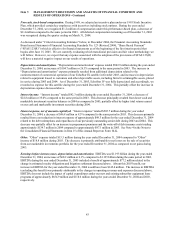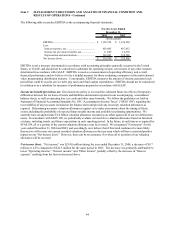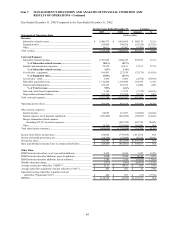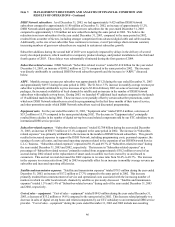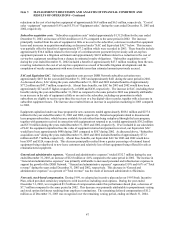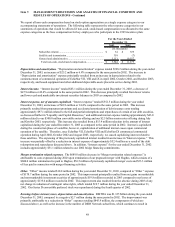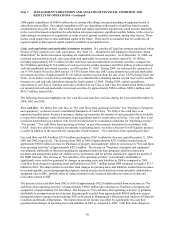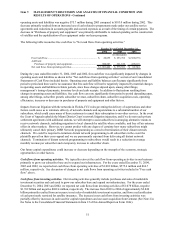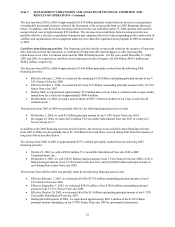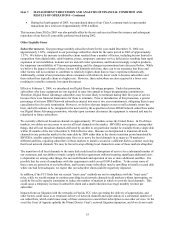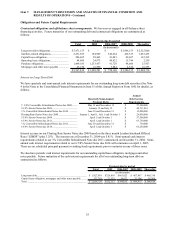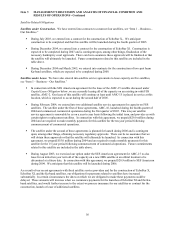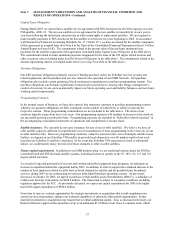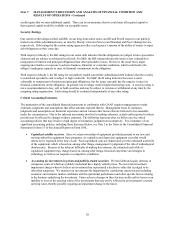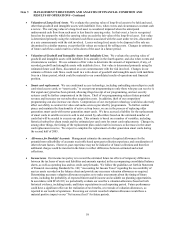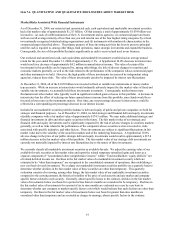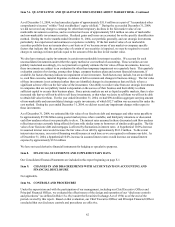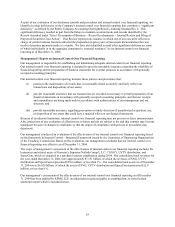Dish Network 2004 Annual Report Download - page 61
Download and view the complete annual report
Please find page 61 of the 2004 Dish Network annual report below. You can navigate through the pages in the report by either clicking on the pages listed below, or by using the keyword search tool below to find specific information within the annual report.
Item 7. MANAGEMENT’S DISCUSSION AND ANALYSIS OF FINANCIAL CONDITION AND
RESULTS OF OPERATIONS - Continued
53
• During the fourth quarter of 2003, we repurchased shares of our Class A common stock in open market
transactions for a total cost of approximately $190.4 million.
This increase from 2002 to 2003 was also partially offset by the net cash received from the issuance and subsequent
repurchase of our Series D convertible preferred stock during 2002.
Other Liquidity Items
Subscriber turnover. Our percentage monthly subscriber churn for the year ended December 31, 2004 was
approximately 1.62%, compared to our percentage subscriber churn for the same period in 2003 of approximately
1.57%. We believe the increase in subscriber churn resulted from a number of factors, including but not limited to
competition from digital cable, cable bounties, piracy, temporary customer service deficiencies resulting from rapid
expansion of our installation, in-home service and call center operations, and from increasingly complex products,
the temporary unavailability of Viacom programming, and the changes in promotional mix discussed below. While
we believe the impact of many of these factors will diminish with time, there can be no assurance that these and
other factors will not continue to contribute to relatively higher churn than we have experienced historically.
Additionally, certain of our promotions allow consumers with relatively lower credit to become subscribers and
these subscribers typically churn at a higher rate. However, these subscribers are also acquired at a lower cost
resulting in a smaller economic loss upon disconnect.
Effective February 1, 2004, we introduced our Digital Home Advantage program. Under this promotion,
subscribers who lease equipment are not required to enter into annual or longer programming commitments.
Therefore, Digital Home Advantage subscribers may be more likely to terminate during their first year of service
because there is no financial disincentive for them to terminate. Prior to introduction of this promotion, a greater
percentage of our new DISH Network subscribers entered into one or two year commitments, obligating them to pay
cancellation fees for early termination. However, we believe that any impact on our overall economic return has
been, and will continue to be, mitigated in the near term by the acquisition of more DISH Network subscribers under
our Digital Home Advantage promotion, whereby upon customer disconnect the equipment is returned and may be
redeployed to future subscribers.
We currently offer local broadcast channels in approximately 155 markets across the United States. In 38 of those
markets, two dishes are necessary to receive all local channels in the market. SHVERA now requires, among other
things, that all local broadcast channels delivered by satellite to any particular market be available from a single dish
within 18 months of the law’s December 8, 2004 effective date. Because we had planned to transition all local
channels in any particular market to the same dish by 2008 rather than in the shorter transition period mandated by
SHVERA, satellite capacity limitations may force us to move the local channels in as many as 30 markets to
different satellites, requiring subscribers in those markets to install a second or a different dish to continue receiving
their local network channels. We may be forced to stop offering local channels in some of those markets altogether.
The transition of all local channels to the same dish could result in disruptions of service for a substantial number of
our customers, and our ability to timely comply with this requirement without incurring significant additional costs
is dependent on, among other things, the successful launch and operation of one or more additional satellites. It is
possible that the costs of compliance with this requirement could exceed $100.0 million. To the extent some of
those costs are passed on to our subscribers, and because many subscribers may be unwilling to install a second dish
where one had been adequate, we expect that our subscriber churn could be negatively impacted.
In addition, if the FCC finds that our current “must carry” methods are not in compliance with the “must carry”
rules, while we would attempt to continue providing local network channels in all markets without interruption, we
could be forced by capacity constraints to reduce the number of markets in which we provide local channels. This
could cause a temporary increase in subscriber churn and a small reduction in average monthly revenue per
subscriber.
Impacts from our litigation with the networks in Florida, FCC rules governing the delivery of superstations, and
other factors could cause us to terminate delivery of network channels and superstations to a substantial number of
our subscribers, which could cause many of those customers to cancel their subscription to our other services. In the
event the Court of Appeals upholds the Miami District Court’s network litigation injunction, and if we do not reach


